Free Primary Market Research

[YOUR COMPANY NAME] is undertaking a primary market research study to explore the feasibility and requirements for entering new markets or launching new products. This comprehensive research is designed to provide essential insights to guide strategic decisions and ensure successful market penetration.
Researcher: [YOUR NAME]
Email: [YOUR EMAIL]
Company Number: [YOUR COMPANY NUMBER]
Company Address: [YOUR COMPANY ADDRESS]
Website: [YOUR COMPANY WEBSITE]
I. Research Objectives
A. Market Feasibility:
Demand Assessment: Evaluate the current and future demand for new products or services in the target market. This involves estimating the market size, and growth potential, and identifying key customer segments.
Market Trends: Analyze ongoing market trends and emerging opportunities that could influence the success of the new product. This includes technological advancements, economic conditions, and consumer behavior shifts.
Revenue Potential: Determine potential revenue streams and profitability by assessing market saturation, pricing strategies, and consumer purchasing power.
B. Competitive Landscape:
Competitor Analysis: Identify major competitors and analyze their market share, strengths, weaknesses, and strategies. Understand their product offerings, pricing models, and market positioning.
Competitive Advantages: Determine what unique value propositions or competitive advantages your product or service can offer compared to existing options in the market.
Market Entry Barriers: Evaluate potential barriers to entry, such as high competition, regulatory hurdles, or significant capital requirements. Assess how these barriers might impact market entry.
C. Consumer Preferences:
Consumer Insights: Gather detailed information on consumer preferences, including desired product features, pricing sensitivity, and purchasing behaviors. Identify key factors that influence consumer choices and brand loyalty.
Adoption Willingness: Measure the willingness of potential customers to adopt the new product or service. Understand their readiness for innovation and potential adoption challenges.
Feedback Collection: Use surveys, interviews, and focus groups to collect direct feedback from potential customers. Analyze this feedback to refine product features and marketing strategies.
D. Regulatory and Compliance Requirements:
Regulatory Review: Investigate relevant regulations and compliance standards required for market entry. This includes industry-specific regulations, safety standards, and environmental considerations.
Legal Barriers: Identify any legal or regulatory challenges that could affect market entry. Understand the legal requirements for product certification, labeling, and distribution.
Cost Implications: Assess the cost implications of meeting regulatory requirements. This includes understanding the expenses related to compliance, certifications, and potential legal fees.
II. Methodology
A. Surveys:
Design and distribute surveys to a representative sample of potential customers. Surveys will collect quantitative data on market demand, consumer preferences, and pricing expectations.
Use online survey platforms or in-person methods to reach the target audience effectively.
B. Interviews:
Conduct in-depth interviews with industry experts, potential customers, and key stakeholders. These interviews will provide qualitative insights into market dynamics and consumer attitudes.
Utilize structured and semi-structured interview formats to gather detailed and actionable information.
C. Focus Groups:
Organize focus group discussions with small groups of potential customers to explore their opinions, perceptions, and reactions to the new product or service.
Use these sessions to gain a deeper understanding of consumer needs and potential market challenges.
D. Competitive Analysis:
Perform a thorough competitive analysis to understand the competitive landscape. This includes researching competitors' market strategies, strengths, weaknesses, and market positioning.
Utilize secondary data sources, industry reports, and competitive intelligence tools to gather relevant information.
III. Timeline
Activity | Start Date | End Date |
|---|---|---|
Research Start Date | January 1, 2050 | - |
Data Collection Period | January 2, 2050 | February 15, 2050 |
Analysis and Reporting | February 16, 2050 | March 31, 2050 |
Final Report Submission | April 5, 2050 | - |
IV. Contact Information
For further details or inquiries regarding this market research, please contact [YOUR NAME] at [YOUR EMAIL]. You can also visit our website at [YOUR COMPANY WEBSITE] for additional information.
This research is conducted by [YOUR COMPANY NAME] to provide a comprehensive understanding of market opportunities and support strategic planning for effective market entry and product launch.
- 100% Customizable, free editor
- Access 1 Million+ Templates, photo’s & graphics
- Download or share as a template
- Click and replace photos, graphics, text, backgrounds
- Resize, crop, AI write & more
- Access advanced editor
Efficiently gather and analyze market insights with our Primary Market Research Template available on Template.net. This customizable and editable template, designed for seamless integration with your AI Editor Tool, ensures accurate and comprehensive data collection. Perfect for market analysts and business strategists, it simplifies the research process and boosts your data-driven decision-making.





























